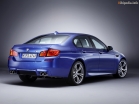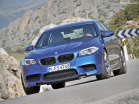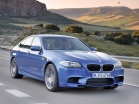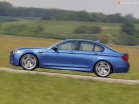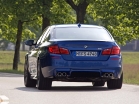Test drive BMW M5 F10 since 2011 sedan
Compulsive test: Jaguar XFR, BMW M5
 There was a BMW M5, there is and will probably always be a standard in the world of super -scholes, so the new Jaguar XFR cannot avoid a duel with a recognized favorite
There was a BMW M5, there is and will probably always be a standard in the world of super -scholes, so the new Jaguar XFR cannot avoid a duel with a recognized favorite Day driving Jaguar XFR makes you believe in the impossible. But the point here is not in the speed from which it is breathtaking, and not in excellent controllability. This is more than just a quick sedan. The world was waiting for this car for half a century. Did XFR justify hopes? Hopes, which, as it seemed yesterday, is never destined to come true.
In 1959, Jaguar made its first athlete, putting a 3.8-liter engine on the popular MK2 model MK2. The exceptional speed potential of that car was surprisingly combined with innate nobility, and he rightly took a place on a par with the legendary Jaguar models. Alas, MK2 3.8 did not have a worthy heir. This lasted 50 years until XFR appeared.
For Jaguar, this is a huge step forward, but is the XFR able to change the balance of power in the class of super -scholes? The BMW M5 will help us answer this question, the authority of which does not need comments. These cars are very close in price, power, dynamic indicators and image. Only sitting behind the wheel, you will understand that each of them has its own special taste.
The war of the engines
Shooting arrival on M5 on winding roads on the hills of Andalusia leaves no doubt about the complexity of the task facing the new XFR. Armed with the V10 and a 7-speed robotic gearbox, BMW immediately gives the impression of a more progressive car compared to Jaguar, which is content with the V8 motor and a traditional automaton. And even before you get the courage to press the Power button next to the KP selector, using all 507 Bavarian horses. For a 4-door sedan, M5 habits are aggressive to indecent. For example, at 6000 rpm, when the Jaguar motor reaches its maximum power, BMW just spreads its wings. And from the piercing sound of the German V10 for 8000 rpm of/min, blood is freezing.
But the racing nature of the M5 motor also has a flip side. The peak torque is small - only 520 nm - and is reached only at 6100 rpm, so that the engine has to be diligently twisted to use all its potential and maintain the pace that the XFR sets.
A completely new 5 -liter compressor engine on Jaguar is not captivated by power (510 hp) and not even a torque (625 nm), and the fact that this colossal thrust is already available from 2500 rpm and does not fade up to 5500 rpm. According to rumors, the engine is capable of more, but the engineers had to sniff it a little due to fears for the health of the transmission.
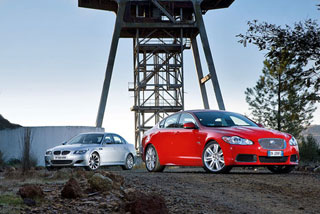 The XFR engine works quietly - quieter than the V10 on M5 or 4.2 -liter compressor V8 on the XF SV8 now removed from production. Because of this, the driver seems that the speed is given to Jaguar easily. Even too easy and natural, because when dispersing gas to the floor sometimes I want more saturated sound accompaniment. However, the XFR, according to the plan of its creators, is not only athletes, but also a comfortable business class car, and in the business class it is customary to do its job without unnecessary noise.
The XFR engine works quietly - quieter than the V10 on M5 or 4.2 -liter compressor V8 on the XF SV8 now removed from production. Because of this, the driver seems that the speed is given to Jaguar easily. Even too easy and natural, because when dispersing gas to the floor sometimes I want more saturated sound accompaniment. However, the XFR, according to the plan of its creators, is not only athletes, but also a comfortable business class car, and in the business class it is customary to do its job without unnecessary noise. It is indicated by one figure about how well the XFR does its job: it performs overtaking acceleration from 80 to 110 km/h in just 1.9 s. As noted in Jaguar, only Mercedes Slr McLaren is capable of among cars with automatic transmission to a faster jerk. The coveted hundred XFR is gaining less than 5 s, and accelerates up to less than 10 s to 160 km/h, and rapidly disappearing in the rear view mirrors M5 convincingly confirms the dynamic characteristics declared by the manufacturer.
It is not easy for the M5 driver to keep up for XFR because BMW is not fast enough. With a clear speed, Emka has a complete order, but due to the relatively modest torque of the motor, you need to carefully monitor the choice of transmission. Nevertheless, during the day, Jaguar regularly went on a margin from BMW, clearly demonstrating its dynamic superiority in overtaking and in other road situations.
The use of a conventional automatic machine, and not more advanced DSG type transmission with two clutches or a robotic box does not spoil the impressions of XFR. But a sophisticated, but not always obedient SMG robot on BMW is one of the weakest M5 places.
The steering wheel switches of the ZF machine on Jaguar allow you to change the gears lightning speed, but the mighty motor reduces the need for this to a minimum. If the M5 has to constantly hunt for optimal speeds, here you can simply turn on the IV transmission and relax using an unlimited engine thrust in the wide range of revolutions.
But for the sophisticated and unfinished BMW driver is a real find. Compared to Jaguar in the character of M5, there is much more enthusiasm, and this enthusiasm is contagious. Someone is the possibility of setting up the engine power and the speed of gear shifts will seem meaningless pampering, but the choice is always better than its absence. In the end, each of us gets behind the wheel with a different mood, and BMW allows you to adapt the car to the tastes of any driver.
SUPERSTAR and young
For many years, different generations of M5 had unconditional superiority over Jaguar athletes, but today everything is not so simple. The more time I spent the BMW drill, the more distinct his age was. The current M5 is already three years old, and five BMWs as such are five. It seems that there are not so many, but in the presence of an ultramodern XFR, these years make themselves felt. And most amazing, most of all this manifests itself in corners.
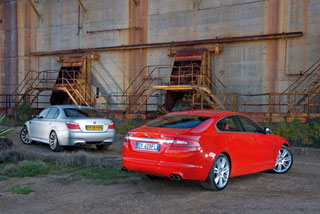 Jaguar’s handling was never standard due to the fact that the company's marketers insisted on softer and comfortable suspension settings, and engineers did not use the differential of increased friction on the rear axle. Now everything has changed. XFR received the active differential of ADC, borrowed from Range Rover. Electronics changes the degree of differential blocking from 0 to 90% and allows you to reveal such abilities of the XF chassis, which could only be guessed before.
Jaguar’s handling was never standard due to the fact that the company's marketers insisted on softer and comfortable suspension settings, and engineers did not use the differential of increased friction on the rear axle. Now everything has changed. XFR received the active differential of ADC, borrowed from Range Rover. Electronics changes the degree of differential blocking from 0 to 90% and allows you to reveal such abilities of the XF chassis, which could only be guessed before. A modified suspension makes a contribution to the case. The stiffness of the springs is increased by 30% compared to the SV8 version, the reptile stabilizers are replaced by thicker, and the CATS adaptive shock absorbers gave way to the more advanced Adaptive Dynamics system, which smoothly changes the stiffness of the racks in the widest range, and not just switches between several fixed modes.
However, self -locking differentials, as practice shows, often provoke insufficient rotation at low speeds, and XFR is no exception. At the output of a slow turn, the differential helps the rear wheels cling to the asphalt better, but the front tires sometimes cannot cope with side overloads and begin to slip out. Fortunately, there is a way to overcome this phenomenon. It is only necessary to turn off the stabilization system, allowing the powerful motor to tear the rear axle into the skid. With the smoke from under the wheels, XFR willingly return to the desired trajectory. Only now you will have to change tires with such a driving manner often.
However, in order to reveal the true character of XFR and enjoy it, extremism is useless. On the high -speed winding highways of the South of Spain, Jaguar demonstrated a composure that is not characteristic of machines with a mass of 2 tons. From the accuracy of reactions to the actions of the steering wheel and iron grip of tires, breathtaking.
The BMW M5 behaves more impudently, but this insolence is not always appropriate. At low speeds, nothing interferes with pleasure at the wheel, and controllability M5 should be recognized more neutral than the XFR. However, with growth in the pace, keeping up for Jaguar in corners becomes more difficult. BMW holds the road no worse, but the steering wheel and chassis at high speed become insufficiently informative. And if the asphalt is not accurately, the suspension does not so effectively control the vibrations of the body. In general, the M5 is no less fascinating in management than XFR, but more demanding on the driver, his skill and concentration. Only on BMW braking is definitely superior to Jaguar.
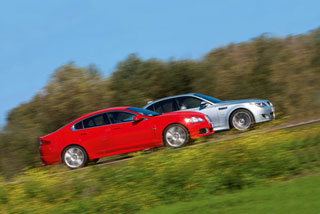 XFR is admiration not because in most cases it allows you to easily leave the M5. There is nothing surprising from the year of the year of speed. But Jaguar managed to raise the speed bar and dynamics to a new height, not sacrificing comfort, which is especially noticeable on the long journey. On the course of the XFR is tougher than any other Jaguar sedan, but this rigidity is never annoying than, alas, M5 cannot boast. Problems with the smoothness of the BMW are especially annoyed, since thanks to a more spacious salon, this car is more suitable for traveling four, and in Jaguar it is cramped in the rear seats.
XFR is admiration not because in most cases it allows you to easily leave the M5. There is nothing surprising from the year of the year of speed. But Jaguar managed to raise the speed bar and dynamics to a new height, not sacrificing comfort, which is especially noticeable on the long journey. On the course of the XFR is tougher than any other Jaguar sedan, but this rigidity is never annoying than, alas, M5 cannot boast. Problems with the smoothness of the BMW are especially annoyed, since thanks to a more spacious salon, this car is more suitable for traveling four, and in Jaguar it is cramped in the rear seats. But by the aggregate of impressions, the new XFR confidently takes from the M5 revenge for all the previous Jaguar defeats in duels with BMW sports sedans. It used to be wild cats for aristocracy and smoothness, turning a blind eye to shortcomings in the dynamics. Today, XFR gives a battle M5 on all fronts. Contrary to the declared indicators of Jaguar overclocking faster on straight and more obedient in corners. Managing them is no less pleasant, and squeezing all the juices from it is much easier. If you do not rush anywhere, it turns out that it is quieter and comfortable. Finally, XFR is cheaper.
Just do not think that the BMW M5 has suffered a crushing defeat. No no and one more time no! If you need a car that requires training, like a wild stallion, if a daring character is more important for you than the smoothness of the course, then the M5 is still out of competition. This model was, is and will be an extra-class sports car, which is skillfully pretended to a family sedan.
Nevertheless, most drivers, if they get to ride these two cars, most likely come to the conclusion that XFR is better. However, there is one but. Jaguar took 50 years to reaches the level of the best sports sedans in the world. The new M5 will appear in just a year. But this year can change a lot.
Specifications
Jaguar XFR
BMW M5
Dimensions, mm 4961x1877x1460
4855x1846x1469
Equipped mass, kg 1891
1855
V8 gasoline engine type with compressor
gasoline v10
Working volume, cubic meter. cm 5000
4999
Max. Power, L.S./rpm 510/6000
507/7750
Max. moment, nm/rpm 625/2500
520/6100
The transmission is automatic 6-band
robotized 7-speed
The rear drive
rear
Max. speed, km/h 250*
250*
Acceleration time, 0100 km/h, with 4.9
4.7
Fuel consumption (average), 12.8
14,8
* With an electronic limiter.
Andrew Frenkel
Photo by Stan Papiore
Haymarket Magazines Ltd, Autocar

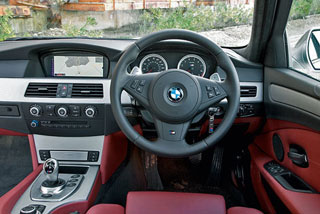
Source: Avtopanorama magazine

